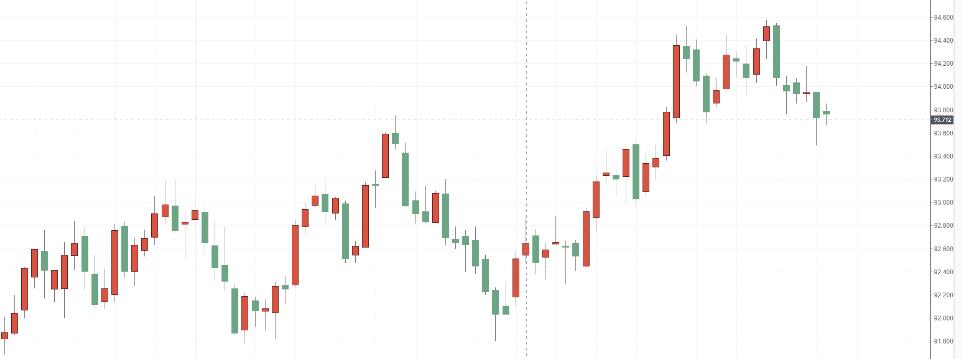Central banks of all countries are more radical than the Fed, and the dollar is exhausted?

Recently, the dollar index futures began to fall after climbing to near the September 2020 high, and fell for five consecutive trading days, falling from the highest of 94.57 to the lowest of 93.49, with an amplitude of 1.14%, and closed at 93.72 on Tuesday.
The Fed may lag behind other central banks
Although the Fed’s latest meeting minutes show that policymakers have hinted that it may start to reduce asset purchases in November, the market’s expectations of the Fed’s interest rate hike are not radical. Except for the European Central Bank, most other central banks are expected to move faster. Raise interest rates.
According to the pricing of the interest rate swap market, the market expects that the Fed will raise interest rates by 25 basis points in September next year. However, at the same time, it is expected that the Reserve Bank of New Zealand may have raised interest rates five times, the Bank of Canada will raise interest rates three times, and the Bank of England will raise interest rates four times.
Although the market’s expectations for the normalization of other central banks’ monetary policies may be too hawkish, New Zealand has indeed raised interest rates once, Australia has suspended asset purchases, the Bank of Canada has begun to reduce asset purchases, and Bank of England Governor Bailey has repeatedly stated that he wants Be prepared to raise interest rates, except for the Eurozone and the Bank of Japan, which have always emphasized easing. It seems that the Fed is indeed lagging behind in the interest rate hike path, which is not good for the US dollar.
Tonight, the market will focus on the CPI data of the United Kingdom and Canada, which may give guidance on their monetary policy. If the CPI data rises again, the British pound and Canadian dollar will continue to rise.
U.S. economic growth slows
On Tuesday, US housing starts fell unexpectedly in September and building permits fell to a one-year low.
Data show that the seasonally adjusted annual rate of housing starts in the United States in September was 1.555 million, a decrease of 1.6%, the lowest level since April; residential building permits in September were 1.589 million, a decrease of 7.7%, which was since September 2020 The lowest level due to severe shortage of raw materials and labor. This supports expectations of a sharp slowdown in economic growth in the third quarter.
Similarly, the September factory production in the United States announced on Monday also unexpectedly dropped, which was the largest decline in seven months. At the same time, the August data was revised down. This is the first wave of mandatory closure of non-essential enterprises since April 2020. Since the COVID-19 pandemic, US manufacturing output has fallen for the second time for two consecutive months. It further proves that supply constraints are hindering economic growth, and the US economic growth rate in the third quarter may slow down sharply.
According to estimates by the Atlanta Fed, the third quarter of the US gross domestic product (GDP) growth rate was 1.2% year-on-year, which will be significantly lower than the 6.7% growth rate in the second quarter. In addition, investment banks such as Goldman Sachs and Morgan Stanley have repeatedly lowered their GDP estimates for the United States.
The decline in US economic growth is also detrimental to the dollar. However, countries have different ways of responding to the epidemic, coupled with the recent rising inflation, other countries' economic growth may not be so good, and the situation of each country must be treated differently.
technical analysis
The daily chart of the U.S. dollar index shows that the U.S. dollar is currently hovering near the neckline. If it can break upward, the U.S. dollar will perform well in the mid-term. However, the short-term weakness will be weakened. If it continues sideways for a period of time, the double-bottom structure may fail.
The best performer among mainstream currencies in October was the Australian dollar. The Australian dollar rose 3.6% against the US dollar. The current exchange rate is hovering near the neckline. If it breaks upward to form a double bottom structure, it may rise further in the future.
The worst performer in October was the yen, which fell 2.84% against the dollar. At present, the exchange rate has fallen below the previous consolidation range and may continue to fall in the future.
Although the euro has rebounded in the short term, the overall trend is weak, especially if this huge head is formed, the future decline will be amazing.



